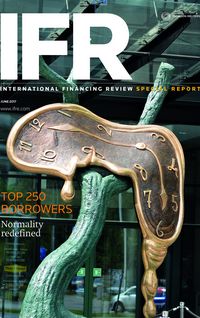Taiwan’s bond market has in recent years enjoyed an issuance bonanza in offshore currencies thanks to regulatory change and onshore institutional investor demand. Can it last?
Taiwan has long perplexed as a geopolitical entity. Regarded as a renegade province by China, 110 miles to its north-west, and ripe for repatriation to the mainland in the latter’s view, the country is a potential tinderbox.
Under the leadership of Tsai Ing-wen, elected in early 2016, the situation is less than stable, but the country is spreading its wings in the international debt capital markets thanks to rampant onshore liquidity.
This has been spurred in 2017 by the appreciation of the New Taiwan dollar, which has jumped by almost 7% since the swearing in of Donald Trump as US President. This move is apparently the result of purchases by the central bank of Taiwan, which has acted in order to “disprove” accusations by the neophyte president that the country is a currency manipulator.
Manipulator or no, you could argue that the moment of Taiwan’s arrival as a player in the international debt markets was cemented late last year when the Kingdom of Saudi Arabia made a stop in Taipei as it marketed its giant bond issue to the country’s flush institutional investors.
This came amid accusations of economic mismanagement as the country’s once heady growth rate has sagged to what appears a new normal of just 2% annual GDP growth, versus the double digits seen in the recent past.
That creates a somewhat bullish rates backdrop, and together with creative thinking on the regulatory front by the Taiwanese financial authorities, helps explain the boom conditions which have been enjoyed by the country’s somewhat unique domestic bond market over the past few years - principally in its domestically hosted primary bond market for issuance denominated in foreign currency.
Formosa bonds - debt issuance in Taiwan in foreign currency and listed on the domestic GreTai exchange - have been the subject of a series of regulatory moves from the country’s financial authorities since 2013, paving the way for a wave of issuance.
That year, Taiwan’s Financial Supervisory Committee (FSC) allowed Taiwanese and foreign banks to issue in renminbi using the Formosa bond market, and as a result, mainland Chinese banks rushed to issue. Such was the volume, that by late 2014 these banks accounted for 65% of total Formosa bond issuance. The market’s potential had been uncovered.
Further regulatory change in April 2015 lowered the funding cost for foreign issuers listing their bonds in Taiwan. At around the same time, Formosa bonds issued by offshore entities and cleared offshore were classified by the FSC as domestic debt, freeing up a vast liquidity pool onshore, given that the ceiling which stipulated no more than 45% of assets could be invested in foreign bonds had effectively been smashed.
And in the process, the regulators were aiming to encourage foreign companies with Taiwan branches to issue in Formosa format.
This move spurred issuance on the back of rampant demand from Taiwan’s institutional investor base, which is perennially awash with liquidity - all the more so, given the regulatory move on Formosa paper.
“Taiwan’s Formosa market has gone from strength to strength on the back of the life insurance sector searching for steady long-term returns. In the first quarter of 2017, we saw new issuance from six US and European corporate investment-grade issuers in deals that were fully subscribed by Taiwan’s life insurers,” said Andrew Stephen, head of private debt syndication, APAC, at Deutsche Bank in Singapore.
The first quarter saw issuance from large universal banks Deutsche Bank, HSBC and Morgan Stanley, as well as US blue-chips including Apple, AT&T, Pfizer and Verizon Communications. This continues the trend seen over the past three years or so for non-financial companies to tap the Formosa market, with issuance having emerged from the likes of EDF and AB InBev.
Verizon printed US$1.48bn of long-dated callable paper in February, while Apple visited with a US$1bn like-format deal, with both trades illustrating the ability of the Formosa market to deliver chunky deal size.
“The Formosa market continues to punch above its weight both in terms of deal size and the high-quality nature of issuers that now consider it a key source of funding,” said Stephen.
Indeed, the Formosa market more or less doubled in size in terms of annual issuance between 2013 and 2015. In 2013, just US$1.27bn-equivalent printed via seven deals, according to data from Thomson Reuters. But by 2016, that had leapt to a staggering US$100bn annual total, according to data from the Taipei Exchange.
Calling for change
Total Formosa issuance in the first quarter of this year hit US$19.5bn, representing a 65% surge year-on-year, according to the Taipei Exchange. This surge can be partially explained by issuers rushing to bring deals ahead of regulatory changes which prohibit local insurance companies in Taiwan from buying bonds carrying calls of less than five years and which became effective in March.
Typically, Formosa bonds have priced in 30-year zero coupon format, carrying a short-dated call feature of two or three years. This became something of a bone of contention for the Formosa market, with the call feature generally accepted as being undervalued or even ignored altogether.
Still - as is often the case in Asia with callable paper - investors had been willing to take the extra spread available on, say, three-year callable Formosa paper, if it offered a pick-up to like-tenor, like-rated dollar paper, which in most cases it did.
But the call risk was hardly immaterial, since many of the older Formosa bonds with short call periods issued around four years ago were indeed called in 2016, and hence proved to be an imperfect instrument for a typical life insurance portfolio which seeks to match long-dated liabilities with long-duration assets. Some US$6.8bn of Formosa paper was called over the first three quarters of 2016, comprising a hefty 25 issues.
It is expected that in the wake of the ruling on short-dated calls, the structure most likely to find its way to the Formosa market will be the 30 non-call five format.
But the market is also capable of absorbing bullet paper, as was eminently demonstrated in late May when South Korea’s Kookmin Bank priced a US$400m five-year FRN, in what represented the largest dollar Formosa issuance from the jurisdiction, as well as the debut of a Korean commercial bank in the Formosa market.
Demand was sufficient to allow an increase from the initially planned US$300m size, and, tellingly in terms of the Formosa market’s ability to deliver a pricing advantage, the deal printed at Libor plus 95bp, inside Kookmin’s plus 100bp funding target at that tenor.
Meanwhile, further regulatory change is likely to change the complexion of the market further, with the FSC mooting opening up the lower part of the ratings curve - at the least the BBB+ and above part - to life insurers, which are at present allowed only to book paper rated Single A or above.
This opens up the universe of financial issuers with paper outstanding in senior format in the Formosa market for potential issuance in Tier 2 format.
“It really looks as if the Formosa market is here to stay, which is in contrast to the view as recently as in early 2016, when issuance dried up thanks to a rising yield hurdle at the lifers, which didn’t chime with what issuers were looking to achieve. But the move to a higher rate environment globally helped sort that,” said a Hong Kong syndicate head.
“The only way I can see issuance drying up again is if there’s a substantial US dollar interest rate rally, and that doesn’t look on the cards any time soon.”
Life-changing
It seems that the durability of the Formosa bond market is also a function of a dramatic change in thinking at the country’s life insurance companies. Somewhat stodgy in their investment behaviour prior to the Formosa boom, most of Taiwan’s life insurers were dyed-in-the-wool buyers of Taiwan government bonds. This trade always seemed unimpeachable, given the country’s solid Double A credit rating, current account surplus and macroeconomic stability - geopolitical tensions with mainland China notwithstanding.
The only caveat was the lousy yields on offer, which were as low as 2% at the 10-year mark on Taiwan dollar government debt. Once the financial authorities grasped the reality that bringing foreign issuers to the local market and tweaking the rules via the classification of Formosa debt as local would actually invigorate the capital market landscape in the country, there was no looking back.
“It’s possible to envisage a situation where the issuance window in dollar primary markets in Asia shuts firmly but, because of its somewhat unique nature as representing a pool of discrete capital, the Formosa market remains open for business. No corporate treasurer looking at dollar funding can afford to ignore this market,” said the Hong Kong syndicate head.
To see the digital version of this special report, please click here
To purchase printed copies or a PDF of this report, please email gloria.balbastro@tr.com



